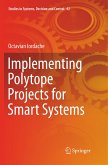High dimensional reference architectures presented here allows confronting and prevailing over the growing complexity of polytopic projects implementations.
Such projects should be envisaged giving that conventional systems operations, equipments, methodologies or organizations will reach their limits for self-evolvability in high complexity conditions. Self-evolvable high complexity systems are based on high dimensional polytopic reference architectures.
Polytope is the general term of the sequence: point, line, polygon, polyhedron and so on.The polytopic projects are targeting the artificiality, not only for materials where it is well known and applied, but also for biological, cognitive, intelligent and mathematical systems. The book highlights the polytopic projects basic similarity despite the noticeable difference as domains of application. The roads to follow and the algebra of changing roads are emphasized.
The book is divided in 9 chapters. Chapter 1 introduces the Polytopic Roadmap to 4D and beyond. The role for the dialogue of processes in duality of the non-Aristotelian Logic of Contradiction and of Included Middle is emphasized for different domains. Chapter 2 refers to chemical systems. Supramolecular chemistry, metal organic frameworks, MOF, and reaction networks, are the examples considered in the frame of polytopic chemistry. Chapter 3 refers to biological systems. Biological dynamical hierarchies and quasi-species are the considered case studies. Technological and scientific projects targeting artificiality for cells and viruses are considered. Chapter 4 refers to cognitive systems. Developmental stages, formal and relational concepts analysis, and neural coding are considered here. The roles of the 4D systems of systems of systems and of conceptual 4D-cube are emphasized. Artificiality for cognitive systems is the object of study.
Chapter 5 refers to mathematical systems. Modeling levels and the 4D digital twins are discussed. Hopf monoids as tools for the study of combinations and separations, dual graded graphs and V-models are informally presented. Chapter 6 refers to application of formal concept analysis, FCA, for high dimensional separations, nesting and drug delivery. Chapter 7 refers to polytopic engineering systems as multiscale transfer, distributors-collectors, cyclic operations, middle vessel columns, mixing, assembly and designs. Equipments have been characterized using Polytopic Roadmaps and classified by Periodic Tables. Chapter 8 introduces polytopic industry, economy, society and sustainability. Chapter 9 outlines new domains of interest as arts and architecture, transdisciplinarity, complex systems and unity of sciences and engineering.
Polytopic Roadmaps are proposed as Method for experts from various fields to synthesize their thinking and capabilities into new projects implementation to face and surpass high complexity. A repetitive finding of this book is that self-evolvability observed in physical systems is based on the same directed sequence of reference architectures as the self-evolvability of concepts in our mind. Continuing to develop the field of self-evolvable systems and presenting the polytopic roadmaps for 4D and beyond advances in ever growing complexity domains, the book will be useful to engineers, researchers, entrepreneurs and students in different branches of production, complex systems sciences and engineering, ecology and applied mathematics.
Such projects should be envisaged giving that conventional systems operations, equipments, methodologies or organizations will reach their limits for self-evolvability in high complexity conditions. Self-evolvable high complexity systems are based on high dimensional polytopic reference architectures.
Polytope is the general term of the sequence: point, line, polygon, polyhedron and so on.The polytopic projects are targeting the artificiality, not only for materials where it is well known and applied, but also for biological, cognitive, intelligent and mathematical systems. The book highlights the polytopic projects basic similarity despite the noticeable difference as domains of application. The roads to follow and the algebra of changing roads are emphasized.
The book is divided in 9 chapters. Chapter 1 introduces the Polytopic Roadmap to 4D and beyond. The role for the dialogue of processes in duality of the non-Aristotelian Logic of Contradiction and of Included Middle is emphasized for different domains. Chapter 2 refers to chemical systems. Supramolecular chemistry, metal organic frameworks, MOF, and reaction networks, are the examples considered in the frame of polytopic chemistry. Chapter 3 refers to biological systems. Biological dynamical hierarchies and quasi-species are the considered case studies. Technological and scientific projects targeting artificiality for cells and viruses are considered. Chapter 4 refers to cognitive systems. Developmental stages, formal and relational concepts analysis, and neural coding are considered here. The roles of the 4D systems of systems of systems and of conceptual 4D-cube are emphasized. Artificiality for cognitive systems is the object of study.
Chapter 5 refers to mathematical systems. Modeling levels and the 4D digital twins are discussed. Hopf monoids as tools for the study of combinations and separations, dual graded graphs and V-models are informally presented. Chapter 6 refers to application of formal concept analysis, FCA, for high dimensional separations, nesting and drug delivery. Chapter 7 refers to polytopic engineering systems as multiscale transfer, distributors-collectors, cyclic operations, middle vessel columns, mixing, assembly and designs. Equipments have been characterized using Polytopic Roadmaps and classified by Periodic Tables. Chapter 8 introduces polytopic industry, economy, society and sustainability. Chapter 9 outlines new domains of interest as arts and architecture, transdisciplinarity, complex systems and unity of sciences and engineering.
Polytopic Roadmaps are proposed as Method for experts from various fields to synthesize their thinking and capabilities into new projects implementation to face and surpass high complexity. A repetitive finding of this book is that self-evolvability observed in physical systems is based on the same directed sequence of reference architectures as the self-evolvability of concepts in our mind. Continuing to develop the field of self-evolvable systems and presenting the polytopic roadmaps for 4D and beyond advances in ever growing complexity domains, the book will be useful to engineers, researchers, entrepreneurs and students in different branches of production, complex systems sciences and engineering, ecology and applied mathematics.








